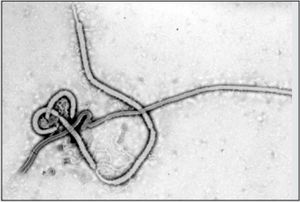Wolbachia-mediated Mosquito vector control against deadly arboviruses
Introduction

By [Kye Duren]
At right is a sample image insertion. It works for any image uploaded anywhere to MicrobeWiki. The insertion code consists of:
Double brackets: [[
Filename: Ebola_virus2.jpg
Thumbnail status: |thumb|
Pixel size: |300px|
Placement on page: |right|
Legend/credit: Electron micrograph of the Ebola Zaire virus. This was the first photo ever taken of the virus, on 10/13/1976. By Dr. F.A. Murphy, now at U.C. Davis, then at the CDC.
Closed double brackets: ]]
Other examples:
Bold
Italic
Subscript: H2O
Superscript: Fe3+
Introduce the topic of your paper. State your health service question, and explain the biomedical issues.
Aedes Mosquitoes: Vectors for the Ages

What Is a disease vector
According to the World Health organization (WHO), a disease vector is a living organism that has the ability to spread infectious diseases between human, animals, and animals and humans. The most successful of which are bloodsucking organisms, like ticks, sand flies, fleas, and mosquitoes that can both receive and transmit diseases through blood meals. WHO also offers that vector-borne diseases, diseases spread by vectors account for 17% of all infectious diseases. At the same time theses vector-borne diseases also account for 1 million deaths annually
Aedes Mosquitoes
Mosquitoes are currently the best known vector system. Arguably the most notorious of these disease vectors hail from the genus Aedes. Aedes mosquitoes are distinguishable by black and white markings on their abdomen, thorax and legs. Aedes mosquito females take blood meals by biting humans and domesticated animals, ingesting their blood, and using it as nutrients to lay eggs. It is in this exchange that potential human pathogens can be transmitted from both host to mosquito and from mosquito to host. The mechanism for Aedes mosquito infection is through the uptake of infected blood, while host infection usually occurs from the secretion of infected saliva. Aedes mosquito saliva contains molecules that limit blood clotting and inflammation, but enhance modulation of the human immune response. At the same time mosquito saliva may cause a decrease in antiviral response as well allowing viral infection to take effect. In addition, unlike other mosquito genuses, these mosquitoes are active daytime biters, which give them a higher chance of interacting with humans. Aedes aegypti and Aedes albopictus mosquitoes are the premier vectors within the genus, making them some of the best disease vectors in the world.
Aedes Aegypti

Aedes aegypti (Ae.ae) mosquitoes appear to be dark-colored mosquitoes with characteristic white lyre- shaped markings and legs incorporating both patterns. Female Ae.ae are daytime mosquitoes, being most active immediately after sunrise and a few hours before sunset. These mosquitoes are stealthy biters as they tend to take blood meals from ankles and elbows, and approach from behind the host. Three days after taking a blood meal, Ae.ae females can lay their eggs. Ae.ae females lay eggs in water natural or artificial water containing vessels above the level of the water. Larvae hatch when rainwater covers the egg. Larvae then undergo the aquatic life cycle to adulthood over the next 7-9 days. Mosquito eggs are quite durable, as they can survive for about 6 months in a dormant state without water. However Ae.ae mosquitoes and their eggs can’t survive in cold temperatures or through the winter. Ae.ae are endemic to Africa, but through international shipping routes, the mosquito is now found in most tropical and subtropical regions. Ae.ae mosquitoes are disease vectors of Dengue virus (DENV), Chikungunya virus (CHIKV), and Yellow Fever, but they have also vectored West Nile virus and Malaria.
Aedes albopictus

Aedes albopictus (Ae. Albopictus) mosquitoes also have a dark color with white-banded legs, but with a longitudinal white stripe along its head and thorax. Ae. albopictus mosquitoes are most active during the dawn hours and the afternoon. Unlike Ae.ae mosquitoes, Ae. albopictus females are aggressive day biters. They prefer biting any exposed skin on humans, but they also take blood meals from both domestic and wild mammals. Ae. albopictus mosquitoes bite rapidly, allowing to take a blood meal before possibly being swatted. About 4-5 days after a blood meal, female Ae. albopictus are ready to lay eggs in natural or artificial containers with water. Like Ae.ae mosquitoes, Rainfall allows larvae to hatch and it takes 7-9 days for larvae to reach adulthood. On the other hand, adult Ae. albopictus eggs persist through the winter in temperate temperature zones, while adult mosquitoes can live year-round in tropical and subtropical regions. Aedes albopictus mosquitoes are also primary vectors of Dengue virus and Chikungunya virus, but they have also been found to transmit Japanese encephalitis virus, yellow fever, and Heartworm parasites.
Viruses vectored by Aedes Mosquitoes
Dengue virus (DENV)

Dengue Virus (DENV), a Flavivirus of the family Flaviridae, is a positive sense RNA virus. DENV is vectored by Aedes mosquitoes. Aedes Mosquitoes become infected with DENV when uninfected females take a blood-meal from infected hosts. From there the virus replicates within the mosquito and translocates to the mosquito salivary gland in order to be transmitted upon the next blood-meal. DENV has 5 serotypes, or distinct genotypes, with DENV-2 being the most aggressive. DENV is the cause of Dengue Fever, a mild fever in most cases, but also induces a serious Hemorrhagic fever (DHF) that can cause liver failure and death. DHF occurs most often in the elderly and early youth populations. (Human infection dynamics) DENV infects 100,000,000 million people a year worldwide, causing serious cases of DHF in 500,000 people, and 20,000 deaths. Currently there is no cure, or vaccine to treat DENV, although DENV is found in tropical and subtropical regions, and over 1 billion people reside in the range of this virus. Currently Dengue Virus is in Hawaii, spreading from two confirmed cases in October 2015 to over one hundred cases as of November 2015.
Chikungunya virus CHIKV
Chikungunya Virus (CHIKV), an alphavirus of the family Togaviridae, is also a positive sense RNA virus. Aedes aegypti mosquitoes were thought to be the sole vector of CHIKV. However, it was discovered that Aedes albopictus mosquitoes can also transmit CHIKV. (Lamballerie et al, 2008) saw that CHIKV virus infecting Aedes albopictus mosquitoes had an Alanine at amino acid 226 on the E1 gene mutated to a valine. Through a single amino acid mutation in the virus, Aedes Albopictus mosquitoes acquired the ability to vector and transmit Chikungunya virus (CHIKV). CHIKV is the cause of mild fever accompanied with an incapacitating arthralgia, or joint pain that can persist for months or even years. Upon the bite of an infected Aedes mosquito, CHIKV replicates within dermal layer of skin and disseminates in to the blood stream. From here, CHIKV predominantly infects the muscles, joints, skin, but also the liver, spleen, and brain, to some capacity. Host immunity launches an inflammatory cell response which leads to the pain and inflammation experienced with this virus. There is also no cure, or vaccine for this virus, and treatments are based on patient symptoms. In 2013, the first case of CHIKV reached the Americas in the Caribbean. According to the CDC, before 2013, there were 28 cases of CHIKV infection a year in the US. By the end of 2014 there were 2,811 in the U.S, and 4,710 in U.S. territories.
Malaria
Yellow Fever
West Nile Virus
Wolbachia
What is Wolbachia

Wolbachia pipentis is a maternally inherited, Gram-negative bacterium. It was discovered within a Culex pipentis mosquito in 1924 by Michael Hertig and Samuel Wolbach. Wolbachia works as an endosymbiont bacterium that takes advantage of its host reproduction in order to proliferate. Wolbachia induces Cytoplasmic incompatibility (CI) in its host, or the failure of a sperm and egg to produce an embryo that supports viable offspring. Wolbachia can induce CI both uni-directionally and bi-directionally. Unidirectional CI occurs when a Wolbachia- infected female attempts to mate with an uninfected male. Bi-directional CI occurs in strain-specific manner, where females and males infected with different strains of Wolbachia can’t form viable offspring. Although the mechanism isn’t well known, Wolbachia are believed to alter chromosomes within their female host, causing complications within mitotic divisions that obstruct the synchrony between sperm and egg. Wolbachia is found within 40% of all terrestrial arthropods. With that said, Wolbachia strains are defined
Wolbachia Controls Mosquitoes and Viruses
Within the last 10-15 years, Wolbachia has been tested against mosquitoes and virus, as an agent to control the spread of mosquito-borne arboviruses. Wolbachia has been shown to be an effective treatment against viral proliferation in mosquitoes, viral transmission from mosquitoes, and even the ability of the mosquito to be infected. Wolbachia has been shown to lower levels of DENV, CHIKV, WNV, YFV, Plasmodium (cause of malaria) in multiple mosquito species including Aedes mosquitoes. The wMelPop However Wolbachia has shown cryptic results that raise trivial questions about the activity of Wolbachia within mosquito vectors. Wolbachia has demonstrated repressive behavior but at evolutionary cost, or even the enhancement of viral transmission [28]. Also mosquito life span was seen to increase when Wolbachia engaged in antiviral response.
Mosquito vector control
Antiviral Response
Density Dependence
Immune Function
ROS Toll pathway Activiation
Gene Expression Regulation
Direct Viral activity
Wolbachia strain wAlbB
Wolbachia strain wMel
Effects of Wolbachia’s strain specific diversity on mosquito vectorship

